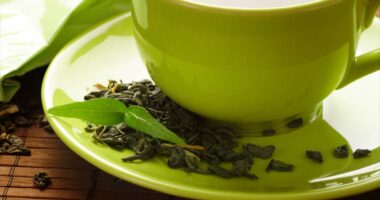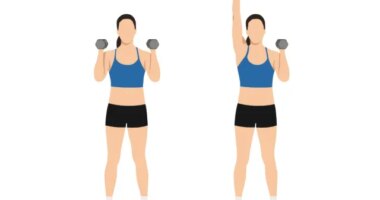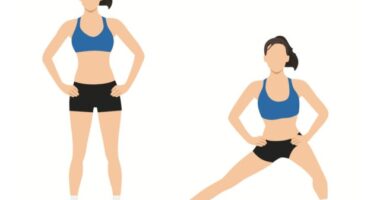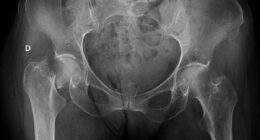Jogging every day is good for the mind, body, and soul. By engaging in this healthy form of physical activity, you’ll give your body and brain a boost. That’s why many individuals make heading out for a casual jog part of their regular fitness routine. However, as you grow older, your body goes through many changes, and exercise can affect you in ways that it hadn’t before. We’re here to share what a daily jogging habit does to your body after 50, according to an expert, so you’re aware of all the pros and cons.
Anyone who loves jogging or is interested in taking it up will want to check out what Perry Mykleby, an ACE-certified personal trainer and fitness expert at ThisIsWhyImFit.com has to say about both the benefits and drawbacks of jogging as you get older.
“There’s no debating the benefits of exercise for health. And that’s where the agreement stops,” Mykleby tells Eat This, Not That! “Proponents of aerobic exercise argue that everyone should jog or run. Others argue that resistance exercise is the best form of exercise. The debate gets more nuanced when the discussion set is narrowed to older adults. Should older adults start [jogging-—or continue [jogging]—after age 50? Here are the benefits and drawbacks of jogging after age 50,” he says.
Keep reading to learn more, and next up, don’t miss 6 Everyday Habits To Regain Muscle Mass After 60, Fitness Expert Says.
Jogging has stellar cardio-respiratory benefits.
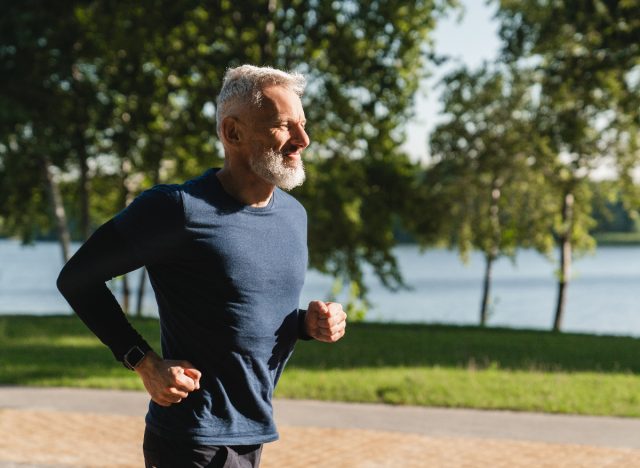

As you grow older, it’s critical to ensure you’re taking care of your heart health. In order to do so, your regular workout routine should involve a cardio-related or aerobic activity, such as daily jogging. As Mykleby puts it, “The clinical literature is packed with data supporting aerobic activity as beneficial for anyone.”
Mykleby also explains that the exercise guidelines from the Centers for Disease Control and Prevention (CDC) call for 150 minutes of low to moderate-intensity exercise per week, noting that “for sure, jogging falls into that category.”
This form of aerobic exercise can improve bone density.
“Resistance exercise is most closely associated with improvement in bone density, but a 2019 study in Frontiers in Physiology pointed to improvements in bone density in exercisers over 50 who ran,” Mykleby explains.
This study looked at individuals who started their exercise journey after 50; not just fitness enthusiasts who already ran and maintained their fitness habits after 50. That’s likely why anyone who’s concerned about their bone health as they age may want to keep up their cardio/jogging regimen.
READ RELATED: 10 Best Chain Restaurant Deals and Freebies You Can Score On Black Friday
Jogging can help ward off dementia.
Mykleby explains that a review of literature on dementia reduction suggests that exercising regularly is key to warding off all-cause dementia. Resistance training and aerobic training are some of the best options, according to the review, so jogging is a solid choice for those who hope to use exercise as a way to prevent age-related issues like dementia.
Beware of un-groomed surfaces that could lead to falls.


Unfortunately, as you grow older, there can be a few drawbacks to keeping up a daily jogging habit. Mykleby cautions, “In much older adults—especially women who are more likely to develop osteoporosis—falls can be catastrophic. Jogging alone doesn’t increase your risk, because it can be done on a track; however, most who jog like the idea of street or trail running, and these surfaces are not groomed for running.”
If this applies to you, Mykleby points out that seams in sidewalks, unevenly paved roads, and tree roots can all potentially cause falls. This risk increases if you’re jogging when it’s dark out.
Older adults could endure soft tissue injuries from jogging.
While anyone can suffer from sprains and soft tissue-related issues while jogging, Mykleby reveals older adults are more likely to deal with soft tissue injuries. If an activity is more intense, or there’s “more risk involved (such as irregular surfaces encountered during street jogging),” this boosts your risk.
On top of that, Mykleby explains, “Older adults’ bodies react differently to the Stretch-Shortening Cycle (SSC) of the muscles than younger people.” Muscle strains and other soft tissue-related injuries are a common reality among older adults.
Knee, hip, and spine issues could occur.
Finally, Mykleby notes that jogging daily could potentially cause issues for your knees, hips, and spine. He explains, “Logic says that the ballistic stress on the knee joint would cause problems and make existing joint problems worse.” Additionally, if you’re dealing with health issues such as obesity or knee valgus (or both), then you may experience pain and lasting knee damage from jogging.
When it comes to the hips, Mykleby says, “Although not as pronounced as the knee, ballistic stresses to the hips are present. Individuals who already have osteoarthritis or wear to the labrum would be most susceptible to further damage.” As far as individuals who “already live with the ‘not if but when’ of hip replacement surgery,” Mykleby says jogging will speed up the process.
As for the spine, Mykleby explains, “Speaking from personal experience, running is ill-advised for post-surgical spine patients. Both surgeons who performed spine surgery on me—one cervical and the other lumbar—advised against running both short and long-term. Non-ballistic forms of exercise were advised.”
Source:




